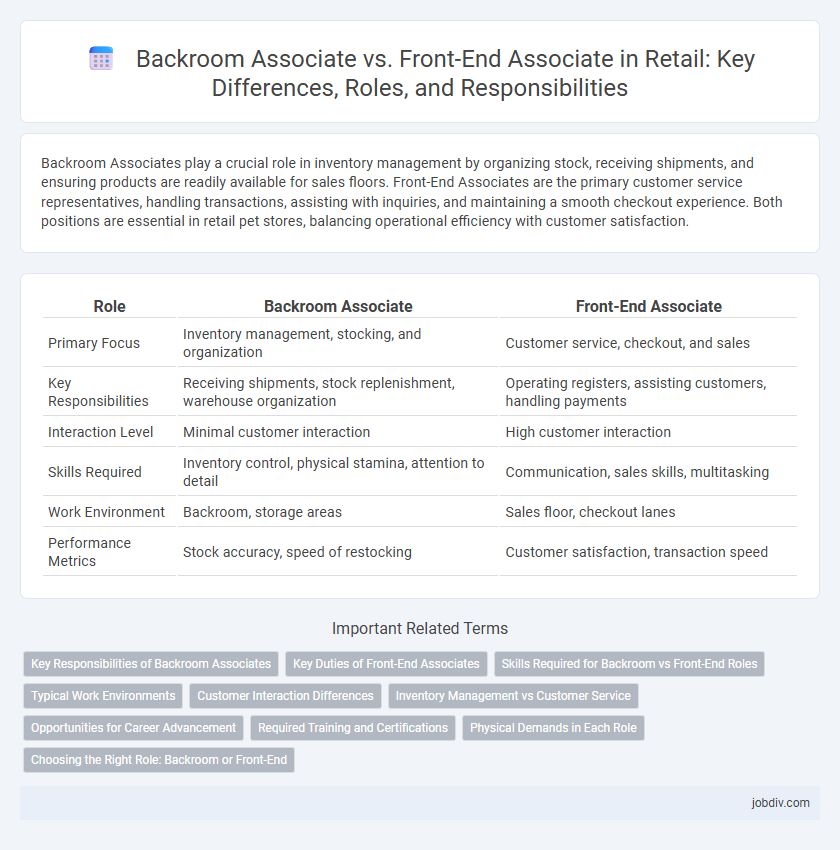Backroom Associates play a crucial role in inventory management by organizing stock, receiving shipments, and ensuring products are readily available for sales floors. Front-End Associates are the primary customer service representatives, handling transactions, assisting with inquiries, and maintaining a smooth checkout experience. Both positions are essential in retail pet stores, balancing operational efficiency with customer satisfaction.
Table of Comparison
| Role | Backroom Associate | Front-End Associate |
|---|---|---|
| Primary Focus | Inventory management, stocking, and organization | Customer service, checkout, and sales |
| Key Responsibilities | Receiving shipments, stock replenishment, warehouse organization | Operating registers, assisting customers, handling payments |
| Interaction Level | Minimal customer interaction | High customer interaction |
| Skills Required | Inventory control, physical stamina, attention to detail | Communication, sales skills, multitasking |
| Work Environment | Backroom, storage areas | Sales floor, checkout lanes |
| Performance Metrics | Stock accuracy, speed of restocking | Customer satisfaction, transaction speed |
Key Responsibilities of Backroom Associates
Backroom Associates manage inventory by receiving shipments, organizing stock, and ensuring accurate product storage to support seamless sales floor replenishment. They handle inventory control, perform regular stock counts, and maintain clean, safe backroom environments to optimize efficiency. This role is crucial for minimizing stock discrepancies and enabling Front-End Associates to focus on customer service and checkout operations.
Key Duties of Front-End Associates
Front-End Associates manage customer transactions, operate cash registers, and provide excellent customer service to ensure a positive shopping experience. They handle price checks, returns, and assist with product inquiries to resolve customer issues promptly. Their key duties prioritize accuracy in cash handling, efficient checkout processes, and maintaining orderly front-end areas to support store operations.
Skills Required for Backroom vs Front-End Roles
Backroom Associates require strong organizational skills, inventory management abilities, and proficiency in stock replenishment systems to efficiently handle storage, sorting, and restocking tasks. Front-End Associates demand excellent customer service skills, cash handling accuracy, and the ability to operate point-of-sale systems while maintaining a positive shopper experience. Both roles benefit from teamwork and communication, but Backroom focuses on logistical precision, whereas Front-End emphasizes interpersonal interaction and transactional accuracy.
Typical Work Environments
Backroom Associates typically work in storage areas, stockrooms, and loading docks, focusing on inventory management and merchandise organization behind the scenes. Front-End Associates primarily operate at checkout lanes and customer service counters, directly engaging with shoppers in retail stores or supermarkets. Both roles require adaptability to fast-paced environments, but Backroom Associates face more physical tasks involving lifting and sorting, while Front-End Associates emphasize customer interaction and transaction processing.
Customer Interaction Differences
Backroom Associates primarily handle inventory management, stock replenishment, and organizing products away from the sales floor, resulting in limited direct customer interaction. Front-End Associates engage directly with customers through checkout processes, addressing inquiries, and providing assistance to ensure a positive shopping experience. The front-end role demands strong communication skills and customer service expertise, while backroom tasks focus more on operational efficiency behind the scenes.
Inventory Management vs Customer Service
Backroom Associates specialize in inventory management, ensuring stock accuracy, receiving shipments, organizing merchandise, and maintaining inventory levels to support seamless store operations. Front-End Associates focus on customer service, handling transactions, assisting with product inquiries, and creating a positive shopping experience at checkout. Effective collaboration between both roles streamlines inventory flow and enhances overall retail efficiency.
Opportunities for Career Advancement
Backroom Associates gain valuable skills in inventory management, stocking, and logistics, which can lead to advancement into supervisory roles or inventory control specialists. Front-End Associates develop expertise in customer service, cash handling, and sales, paving the way for positions such as shift supervisors or store managers. Both roles offer distinct career pathways within retail operations, allowing employees to specialize according to their strengths and interests.
Required Training and Certifications
Backroom Associates typically require training in inventory management, safety protocols, and the use of warehouse equipment such as forklifts, often accompanied by certifications like OSHA forklift operation. Front-End Associates need customer service training, cash handling skills, and proficiency with point-of-sale (POS) systems, with certifications in customer service excellence or basic financial transactions highly valued. Both roles emphasize compliance training in retail loss prevention and workplace safety to maintain operational standards.
Physical Demands in Each Role
Backroom Associates primarily handle tasks requiring heavy lifting, stocking, and organizing inventory, demanding significant physical strength and stamina to manage prolonged periods of walking, bending, and reaching. Front-End Associates engage in standing for extended durations, repetitive scanning, and assisting customers, which requires endurance and dexterity without the intense physical strain of heavy lifting. Both roles necessitate continuous movement, but the backroom position emphasizes strength and manual labor, while the front-end role focuses on endurance and customer interaction.
Choosing the Right Role: Backroom or Front-End
Backroom Associates manage inventory, organize stock, and support supply chain efficiency, ensuring products are ready for the sales floor. Front-End Associates handle customer transactions, provide service, and maintain checkout operations, directly influencing customer satisfaction. Choosing the right role depends on your strengths in operational tasks versus customer interaction within retail environments.
Backroom Associate vs Front-End Associate Infographic

 jobdiv.com
jobdiv.com